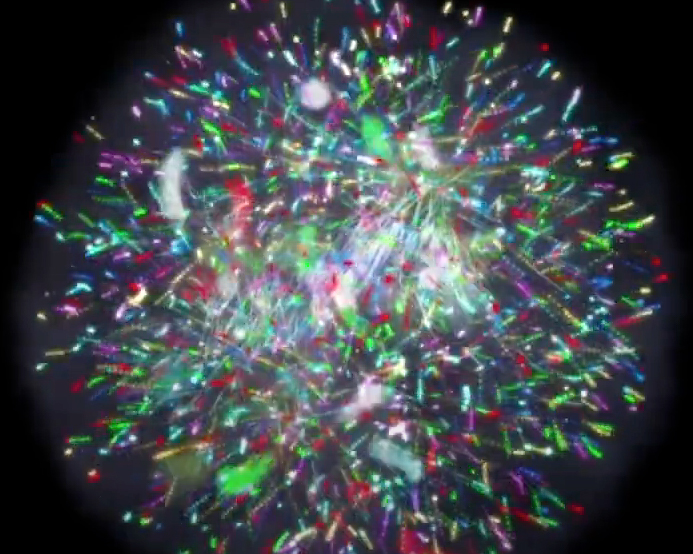A still from the "Visualizing the Proton" animation.
At Jefferson Lab’s 2024 Open House event, visitors can chat with one of the masterminds behind the “Visualizing the Proton” animation and documentary
Upon discovering the nucleus of the atom, the father of nuclear physics, Ernest Rutherford, is credited with telling a colleague, “Now I know what the atom looks like.” Rutherford also later discovered the proton in 1918, and physicists have been building on that knowledge to develop a picture of what the atom’s protons look like ever since. Now, we’re inviting you to picture the proton, too!
On June 8, the U.S. Department of Energy's Thomas Jefferson National Accelerator Facility is holding rolling screenings of a shortened version of the “Visualizing the Proton Documentary,” as well as a short screening of unique animations of the atomic nucleus. The screenings will be held throughout the day and are a featured exhibit at the lab’s open house event, 9 a.m.-3 p.m.
The screenings will be led by Rolf Ent, a Jefferson Lab nuclear physicist and a co-associate director of the Electron-Ion Collider project. Ent will be on hand throughout the day to discuss the animations and documentary project. He will also answer any questions about the physics of the proton.
Get a Head Start: Learn More About a Unique Animation
He says the original idea for the project came from 2006 as nuclear physicists were planning future research. In meetings, the physicists discussed the difficulties of describing their work in a way that was easily understandable to non-physicists.
“We have all this body of data. But the idea here is that even with all of this data, it's very difficult then to explain to people: What do you learn out of it?” Ent said. “We felt we should at least be able to give people some concept about what these data tell us.”
He and Richard Milner, a physics professor at the Massachusetts Institute of Technology, submitted a proposal to the MIT Center for Art, Science & Technology (CAST) to kick-start the project in 2018. CAST supports creative projects at the intersection of art, science and technology.
The idea was to produce animations that would show what protons may look like alongside the scientific data that reveal these details.
“Our aim as physicists was to have an animation to visualize the proton. CAST wanted to tell more the story of how this goes creatively,” Ent said.
Animating the Unseeable
At the heart of the project are vivid animations of the proton and its building blocks. Alongside one of the animations are matching graphs of real data from experiments. These data are what have been re-imagined in the animations. Other animations show information about the experiments and the size scales the animations represent
The animations are featured in an informative, 18-minute video that relates the science to our everyday world and explains it in simple terms.
“At the beginning, we were somewhat worried that we would get all kinds of criticism from our colleague scientists, because some things are a bit of a choice,” Ent said. “But yeah, they accepted it. We didn't get major criticisms. We got feedback, but no major criticism.”
Even more, the animations were shown at the 50th anniversary celebration of QCD in Stockholm in July, 2023. QCD, or quantum chromodynamics, is the accepted theory describing the interactions of the particles inside protons.
The animations have also been widely used in the popular media, for example by an episode of “PBS Space Time.” Ent said the videos are routinely used at MIT and elsewhere in classes on nuclear and particle and physics. The success has led the team to now pursue animations of the atomic nucleus.
The project also produced a 16-minute documentary film on how the group came together to develop the animation. The documentary shows Ent, Milner and former Jefferson Lab physicist Rik Yoshida (now director of the High Energy Physics division at DOE’s Argonne National Laboratory) meeting with James LaPlante, president of Sputnik Animation, to start off the project. Behind the scenes, MIT video artists Chris Boebel and Joe McMaster captured the high points of the process.
At the Jefferson Lab 2024 Open House, Ent will spend time discussing what nuclear physicists have revealed about the proton and what they still have to learn.
“I like physics because it describes nature. To me, that's the ultimate truth that I'm after. That's what I do. But people are different. So, my hope is indeed that we can portray to people better what's so interesting,” said Ent. “It is good to more or less be able to portray to a wide audience how this works. It gives people a better imagination for what is happening, even though they can’t see it.”
Visitors can chat with Ent in the Test Lab conference room, Bus Stop #6, at the Jefferson Lab 2024 Open House event. The free event is open to all on June 8, 9 a.m.-3 p.m. It offers a once-in-a-biennial opportunity for the public to see inside this amazing facility, where groundbreaking research, technology R&D and innovation is happening every day.
For the latest on Jefferson Lab’s 2024 Open House, visit the event website at https://www.jlab.org/openhouse or the Facebook event page at https://www.facebook.com/events/3206270969516653/.
To be added to our event information distribution list for information updates and event reminders, email openhouse@jlab.org.
Further Reading
Visualizing the Proton: Charting the Inner Structure of the Proton video
Visualizing the Proton: A Documentary
Now Presenting: A Visualization of the Proton
Visualizing the Proton through animation and film
By Kandice Carter
Contact: Duane Bourne, Jefferson Lab Communications Office, duane@jlab.org


